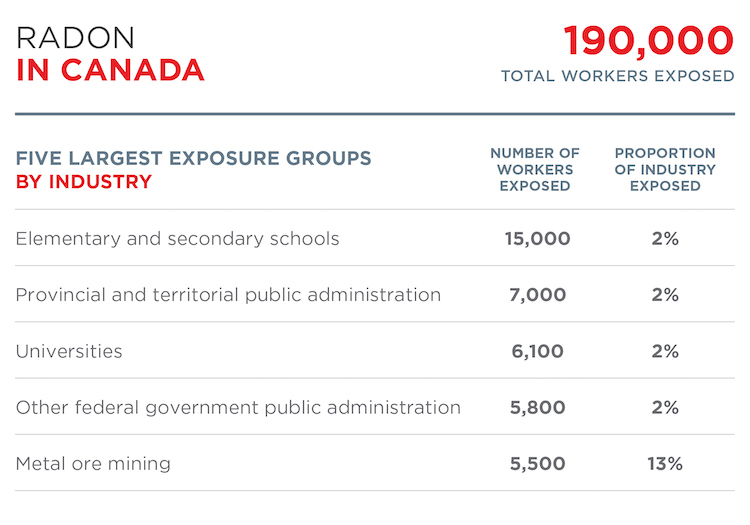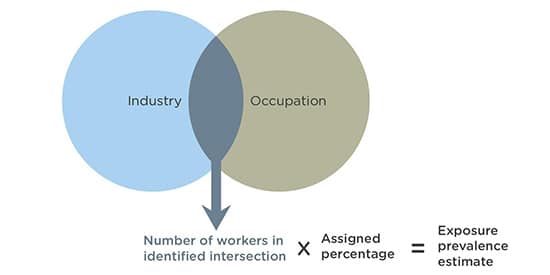Radon Occupational Exposures
Radon Occupational Exposures
Overview
Inhalation is the most important route of exposure in occupational settings.[1] Radon in groundwater, soil, or building materials may enter the work environment and decay into radioactive particles.[2,3] CAREX Canada estimates that approximately 190,000 Canadians are exposed to radon in the workplace.
READ MORE...
By industry, the largest exposed groups are elementary and secondary schools, provincial and territorial public administration, and universities. By occupation, the greatest exposures occur among administrative assistants, general office support workers, receptionists, and elementary school and kindergarten teachers.
Radon levels in confined or underground spaces (particularly in mines) are often elevated compared to outdoor air levels.[1,3] The highest exposed workers are those involved in underground mining, especially for uranium.[4] Other workers who spend time underground (e.g. subway and utility tunnel workers) are also at increased risk in areas where radon is present. Indoor workers of any type may also be exposed, especially if they work in areas and rooms with higher concentrations of radon (e.g. basements).
Other occupations with the potential for exposure to radon include remediation workers (especially of mine sites), phosphate fertilizer producers, researchers who use radon, and construction excavators. There is little information available on the occurrence of radon in Canadian workplaces. There are five active uranium mines in Canada; all are located in Saskatchewan. In 1998, high levels of radon were associated with propane production in British Columbia, with concentrations reaching as high as 4,958 Bq/m3.[5] In Nova Scotia, radon concentrations were collected over a three month period from 21 workplaces that had high potential for radon exposure, including water treatment facilities and coal power stations. The maximum concentration measured was 202 Bq/m3.[6]
Occupational radon exposure measurement is mandated and managed by the Radiation Protection Bureau of Health Canada for uranium miners. This data is held in the National Dose Registry (NDR), which contains exposure data for workers exposed to radiation across Canada.[7]
According to the Burden of Occupational Cancer in Canada project, occupational exposure to radon leads to approximately 190 lung cancers each year in Canada, based on past exposures (1961- 2001).[8,9] This amounts to 0.8% of all lung cancers diagnosed annually. Radon exposure occurs very broadly across workers in many industries. The groups with the largest burden of radon-related cancers are finance, insurance, real estate and leasing; trade; mining and oil and gas extraction; and public administration. Work-related radon exposure resulted in approximately $185 million in costs for newly diagnosed lung cancer cases in 2011.[9]
Prevalence Estimate
Results show that approximately 190,000 Canadians are occupationally exposed to radon; 54% are female. Industries with the greatest number of exposed workers are elementary and secondary schools, provincial and territorial public administration, and universities. When radon exposure is examined by occupation, the groups with the largest number of workers are administrative assistants (9,200 workers exposed), general office support workers (8,700 workers exposed), receptionists (5,400 workers exposed), and elementary school and kindergarten teachers (5,100 workers exposed). However, the workers at risk of highest exposure to radon are people who work in underground mines.
The number of workers exposed to radon stayed approximately the same from 2006 to 2016.
Workers exposed to radon by industry in 2016

Workers exposed to radon by region in 2016
Click the second tab to view total number of workers exposed.
Level of Exposure
In total, approximately 190,000 Canadians are exposed to radon in their workplaces. The majority of workers exposed to radon are in the low exposure category, but a sizeable number are at risk of higher exposure levels.
Workers exposed to radon by exposure level in 2016
Level of exposure by industry
In order to help guide efforts to prioritize exposed groups and target cancer prevention resources most effectively, we identified industries with either: 1) workers exposed to high levels of radon or 2) a larger number of workers exposed to radon.
The table below shows the number of workers exposed by industry group and level of exposure to radon. These results highlight industries with the highest number of workers, as well as industries with the highest levels of exposure.
For example, in educational services industry (including elementary and secondary schools and universities), the majority of workers fall into the low exposure category. However, in the mining quarrying industry, the majority of exposed workers (92%) are in the high exposure category. Depending on the goals of a prevention campaign, exposure reduction strategies could target the largest industrial groups or those at highest risk of exposure.
Workers exposed to radon by exposure level and industry in 2016
*Numbers may not add up due to rounding
Methods and Data
Our Occupational Approach page outlines the general approach used to calculate prevalence and exposure level estimates for workplace exposures.
Data Sources
Data used in developing the occupational estimates for radon were collected from several sources:
- The Canadian Federal Building Survey, which has been conducted by Health Canada since 2007, measures radon concentrations in federal work places using alpha track detectors over at least three months. Our federal building data set included approximately 13,000 samples. No federal buildings were surveyed in Nunavut, so:
- The Cross-Canada Survey of Radon Concentrations (CCRS) was used to calculate radon exposure in Nunavut only. The CCRS is a two year study conducted by Health Canada’s National Radon Program in 2009-2011. Homes in all health regions in Canada were sampled for a minimum of three months using alpha track detectors. Detectors were placed in the room with the lowest elevation in which homeowners occupied at least four hours per day. Individuals who were renting a home, living in high-rise condos that were above the second floor, or living on military bases or on-reserve were not included. The CCRS dataset contains 13,814 samples, with 8,340 (60%) samples collected on the first floor, 4,014 (29%) collected in the basement, and 1,163 (8%) collected on the second floor.
- Canadian and US scientific peer reviewed publications that addressed radon exposure in Canada and the United States.
- Grey literature including technical reports from governments and international bodies.
Prevalence Estimate Method
CAREX Canada defines exposure to radon as inhalation exposure at work above the levels expected in the general environment (i.e. in the home, above the Canadian guideline for radon set by Health Canada, which is 200 Bq/m3).
A two-stage process was used to assess prevalence of exposure: 1) estimating prevalence in workers with high probability of radon contact (i.e. underground workers); and 2) estimating prevalence in indoor work environments where exposure to radon occurs incidentally (such as office buildings and schools).
Estimating prevalence of exposure in workers where direct contact to radon is expected
A series of steps were taken to assign exposure proportions to underground workers at risk of high exposure to radon.

- Occupations and industries at risk of possible exposure to radon were identified via peer reviewed and grey literature.
- The total number of workers in each identified occupation and industry intersection was obtained from Statistics Canada 2016 census data.
- A percentage of workers exposed was assigned to each occupation and industry intersection. Percentages were determined through consultation with existing evidence in the data sources, previously established methods from the Europe CAREX estimates and expert judgement of CAREX occupational hygienists.
- The number of workers in the identified group is multiplied by the assigned percentage to calculate the prevalence estimate of underground workers exposed to radon.
Estimating exposure in indoor workers
To estimate the number of indoor workers exposed to radon in various occupation and industry intersections, we modelled radon concentrations in workplaces and susceptible indoor working populations. Generally:
- Indoor workers at risk of exposure to radon were identified using Statistics Canada 2006 census data and previous estimates of exposure to solar radiation.
- The distributions of indoor workplace radon concentrations by Canadian province/territory were calculated using radon measurements from the Canadian Federal Building Survey (and the Cross-Canada Survey of Radon Concentrations for Nunavut only).
- The distributions of radon concentrations in workplaces and of susceptible populations across different occupations and industries were combined to estimate the prevalence of radon exposure in susceptible indoor working populations.
More specifically, we used previous estimates created by CAREX Canada to identify and exclude outdoor workers (thus creating a subset of the census that only included indoor workers). All occupation-industry matrix cells that were identified and used to estimate prevalence of exposure in underground workers were excluded to avoid double counting.
The distribution of radon concentrations was then applied to the susceptible (indoor) population model to determine the number of workers exposed.
Exposure Level Method
CAREX Canada used distribution parameters from the radon concentration model to calculate the number of workers above exposure level thresholds. Exposure thresholds were >200 to 400 Bq/m3 for low exposure, >400 Bq/m3 to 800 Bq/m3 for moderate exposure, and >800 Bq/m3 for high exposure. Workers were considered to be exposed to “very high” levels of radon if they were identified in the preliminary literature search as being an underground worker with a likely unique exposure scenario.
Category 1: Low Exposure
A group of workers is put in this exposure category if the susceptible working population was exposed to levels between
>200-400 Bq/m3 based on the concentration distributions produced by the radon concentration model.
Category 2: Moderate Exposure
A group of workers is put in this exposure category if the susceptible working population was exposed to levels between
>400-800 Bq/m3 based on the concentration distributions produced by the radon concentration model.
Category 3: High Exposure
A group of workers is put in this exposure category if the susceptible working population was exposed to levels above 800 Bq/m3 based on the concentration distributions produced by the radon concentration model.
Sources
Subscribe to our newsletters
The CAREX Canada team offers two regular newsletters: the biannual e-Bulletin summarizing information on upcoming webinars, new publications, and updates to estimates and tools; and the monthly Carcinogens in the News, a digest of media articles, government reports, and academic literature related to the carcinogens we’ve classified as important for surveillance in Canada. Sign up for one or both of these newsletters below.
CAREX Canada
School of Population and Public Health
University of British Columbia
Vancouver Campus
370A - 2206 East Mall
Vancouver, BC V6T 1Z3
CANADA
As a national organization, our work extends across borders into many Indigenous lands throughout Canada. We gratefully acknowledge that our host institution, the University of British Columbia Point Grey campus, is located on the traditional, ancestral and unceded territories of the xʷməθkʷəy̓əm (Musqueam) people.



